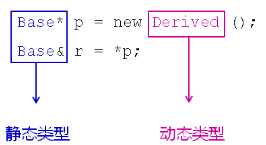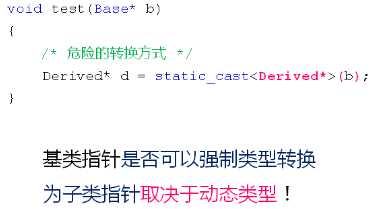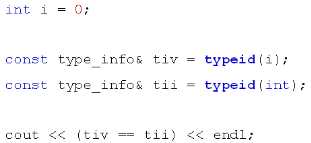标签:image pac 自身 virt derived rtu printf 类型识别 argv
在面向对象中可能出现下面的情况:


C++如何得到动态类型?
解决方案——利用多态:
示例——利用多态动态类型识别:
#include <iostream>
using namespace std;
class Base
{
public:
virtual string type()
{
return "Base";
}
};
class Derived : public Base
{
public:
string type()
{
return "Derived";
}
void printf()
{
cout << "I‘m a Derived." << endl;
}
};
class Child : public Base
{
public:
string type()
{
return "Child";
}
};
void test(Base* b)
{
/* 危险的转换方式 */
// Derived* d = static_cast<Derived*>(b);
if( b->type() == "Derived" )
{
Derived* d = static_cast<Derived*>(b);
d->printf();
}
// cout << dynamic_cast<Derived*>(b) << endl;
}
int main(int argc, char *argv[])
{
Base b;
Derived d;
Child c;
test(&b);
test(&d);
test(&c);
return 0;
}运行结果为:
[root@bogon Desktop]# g++ test.cpp
[root@bogon Desktop]# ./a.out
I‘m a Derived.多态解决方案的缺陷:
C++提供了typeid关键字用于获取类型信息:
typeid关键字的使用:

typeid的注意事项:
示例——typeid动态类型识别:
#include <iostream>
#include <typeinfo>
using namespace std;
class Base
{
public:
virtual ~Base() { }
};
class Derived : public Base
{
public:
void printf()
{
cout << "I‘m a Derived." << endl;
}
};
void test(Base* b)
{
const type_info& tb = typeid(*b);
cout << tb.name() << endl;
}
int main(int argc, char *argv[])
{
int i = 0;
const type_info& tiv = typeid(i);
const type_info& tii = typeid(int);
cout << (tiv == tii) << endl;
Base b;
Derived d;
test(&b);
test(&d);
return 0;
}运行结果为:
[root@bogon Desktop]# g++ test.cpp
[root@bogon Desktop]# ./a.out
1
4Base
7Derivedtypeid在不同的编译器下行为不一样(也就是说打印出来的类型名是不一样的)。
标签:image pac 自身 virt derived rtu printf 类型识别 argv
原文地址:https://www.cnblogs.com/PyLearn/p/10095652.html